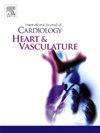Using integrative bioinformatics approaches and machine–learning strategies to identify potential signatures for atrial fibrillation
IF 2.5
Q2 CARDIAC & CARDIOVASCULAR SYSTEMS
引用次数: 0
Abstract
Atrial fibrillation (AF) is the most common tachyarrhythmia and seriously affects human health. Key targets of AF bioinformatics analysis can help to better understand the pathogenesis of AF and develop therapeutic targets. The left atrial appendage tissue of 20 patients with AF and 10 patients with sinus rhythm were collected for sequencing, and the expression data of the atrial tissue were obtained. Based on this, 2578 differentially expressed genes were obtained through differential analysis. Different express genes (DEGs) were functionally enriched on Gene Ontology (GO) and Kyoto Encyclopedia of Genes and Genomes (KEGG), mainly focusing on neuroactive ligand-receptor interactions, neuronal cell body pathways, regulation of neurogenesis, and neuronal death, regulation of neuronal death, etc. Secondly, 14 significant module genes were obtained by analyzing the weighted gene co-expression network of DEGs. Next, LASSO and SVM analyzes were performed on the differential genes, and the results were in good agreement with the calibration curve of the nomogram model for predicting AF constructed by the weighted gene co-expression network key genes. The significant module genes obtained by the area under the ROC curve (AUC) analysis were analyzed. Through crossover, two key disease characteristic genes related to AF, HOXA2 and RND2, were screened out. RND2 was selected for further research, and qPCR verified the expression of RND2 in sinus rhythm patients and AF patients. Patients with sinus rhythm were significantly higher than those in AF patients. Our research indicates that RND2 is significantly associated with the onset of AF and can serve as a potential target for studying its pathogenesis.
求助全文
约1分钟内获得全文
求助全文
来源期刊

IJC Heart and Vasculature
Medicine-Cardiology and Cardiovascular Medicine
CiteScore
4.90
自引率
10.30%
发文量
216
审稿时长
56 days
期刊介绍:
IJC Heart & Vasculature is an online-only, open-access journal dedicated to publishing original articles and reviews (also Editorials and Letters to the Editor) which report on structural and functional cardiovascular pathology, with an emphasis on imaging and disease pathophysiology. Articles must be authentic, educational, clinically relevant, and original in their content and scientific approach. IJC Heart & Vasculature requires the highest standards of scientific integrity in order to promote reliable, reproducible and verifiable research findings. All authors are advised to consult the Principles of Ethical Publishing in the International Journal of Cardiology before submitting a manuscript. Submission of a manuscript to this journal gives the publisher the right to publish that paper if it is accepted. Manuscripts may be edited to improve clarity and expression.
 求助内容:
求助内容: 应助结果提醒方式:
应助结果提醒方式:


